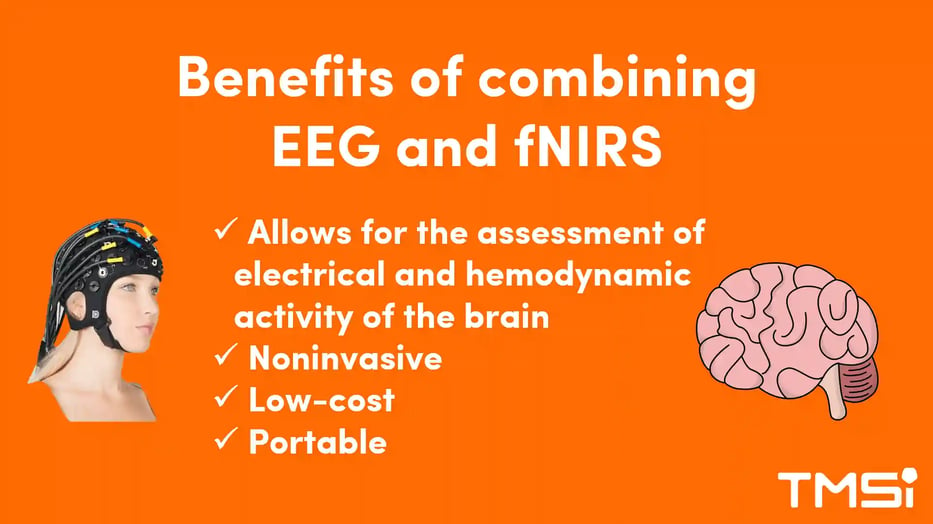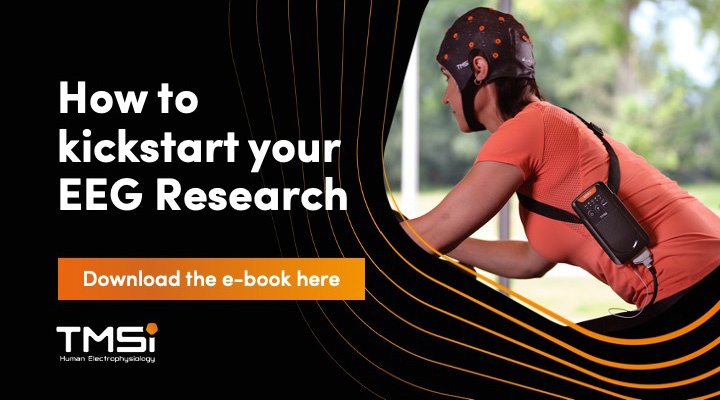Explaining the integration of EEG & fNIRS
What are multimodal functional neuroimaging measurements and why are they used?
“The whole is greater than the sum of the parts.” This quote by the famous Greek philosopher, Aristotle, relates to what multimodal functional neuroimaging aims to do. While a single functional neuroimaging technique is often sufficient for neuroscience applications, some applications require a combination of methods.
Multimodal functional neuroimaging allows for the assessment of two or more complementary features of brain activity to expand the knowledge about brain functioning and neuronal behavior.1 It is done by combining a method that measures neuronal electrical activity, electroencephalography (EEG) or magnetoencephalography (MEG), with a measure of hemodynamic activity: functional magnetic resonance imaging (fMRI), positron emission tomography (PET), or functional near-infrared spectroscopy (fNIRS).1
In this blog, we will discuss the integration of EEG and fNIRS, and the benefits this has in research.
What is EEG?
EEG is a common, widely used technique of neuroimaging that records electrical activity in the brain. It has excellent temporal resolution by directly measuring the electrical activity of the brain at the scalp at relatively high sampling rates. It is a popular technique because it is non-invasive, cost-effective, and portable.
What is fNIRS?
fNIRS is a technique that measures brain activity by assessing changes in cortical hemodynamic activity using near-infrared (NIR) light.2 Like fMRI, fNIRS can measure the blood oxygen level-dependent (BOLD) response of the brain. Also, while fMRI, has high cost and requires participants to remain still during measurements, fNIRS provides a low-cost and portable solution that gives the opportunity to record in realistic environments and to measure tasks that require movement. The measured responses of fNIRS lie roughly 1-2 cm of the activated area, giving a higher degree of localization for this modality compared with EEG.3 This allows for more accurate identification of the cortical response areas than with EEG alone.
 Figure 1: Benefits of combining EEG and fNIRS
Figure 1: Benefits of combining EEG and fNIRS
What are the benefits of combining EEG and fNIRS?
EEG and fNIRS reflect distinct but closely related aspects of the underlying neuronal activity, carrying complementary information. It has the ability to explore neurovascular coupling by obtaining electrical activity and hemodynamic responses to stimuli. Furthermore, these modalities are both portable, allowing for various research settings and realistic measurement setup possibilities.
Where can I find a device that measures EEG & fNIRS?
Developing a device that can combine the measurement of EEG & fNIRS can be quite challenging. These challenges can arise from coupling the EEG electrodes and fNIRS optodes to the head of the subject, the challenge of achieving time synchronization, and the potential for electrical crosstalk.1 However, we at TMSi, along with our partner Artinis, have developed a new electrode and electrode/optode holder to be able to use both EEG and fNIRS sensors together at the same location. With this, Artinis has seamlessly integrated EEG and fNIRS into a truly combined system. Interested to know more? Contact us at sales@tmsi.com.

Figure 2: Combined NIRS-EEG holder. Left: Isometric top view of the EEG electrode and the NIRS optode. Right: The isometric bottom view of the EEG electrode, NIRS optode, and EEG gel. [From Artinis]
Which applications can the combination of EEG & fNIRS be used?
Some of the applications combining fNIRS and EEG include brain-computer interface (BCI), hyperscanning, and clinical research in stroke, Parkinson’s disease, and epilepsy.1
Conclusion
As mentioned above, combining EEG and fNIRS allows for the assessment of electrical and hemodynamic activity of the brain. Both methods are non-invasive, have low-cost modalities, and are portable, allowing various possibilities for your research. Are you interested in fNIRS integrated EEG measurements? At TMSi we offer the combination of fNIRS and EEG devices to suit your research design.
References
- Uchitel J, Vidal-Rosas EE, Cooper RJ, Zhao H. Wearable, Integrated EEG-fNIRS Technologies: A Review. Sensors (Basel). 2021;21(18):6106. Published 2021 Sep 12. doi:10.3390/s21186106
- Boas DA, Elwell CE, Ferrari M, Taga G. Twenty years of functional near-infrared spectroscopy: introduction for the special issue. Neuroimage. 2014;85 Pt 1:1-5. doi:10.1016/j.neuroimage.2013.11.033
- Wilcox T, Biondi M. fNIRS in the developmental sciences. Wiley Interdiscip Rev Cogn Sci. 2015;6(3):263-283. doi:10.1002/wcs.1343

